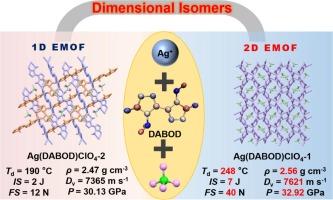通过尺寸异构提高高能金属有机框架的稳定性和能量性能
IF 6.7
1区 工程技术
Q2 ENERGY & FUELS
引用次数: 0
摘要
高能晶体学框架既是机遇也是挑战。虽然异构化是设计高能分子的关键策略,但其在高能金属有机框架(EMOFs)中的应用尚未得到充分探索。在此,我们首次报告了由相同构筑基块自组装的 EMOF 框架维度异构体的结晶。以 4,4′-二氨基-[3,3′-双(1,2,4-恶二唑)]-5,5′(4H,4′H)-二酮(DABOD)为配体,通过改变溶液环境,制备了具有二维框架的 Ag(DABOD)ClO4-1 和具有一维框架的 Ag(DABOD)ClO4-2 两种异构体。详细的结构分析表明,有机连接体的不同配位位点和金属原子的不同配位模式导致形成了不同尺寸的框架结构。值得注意的是,与一维 EMOF 相比,二维 EMOF 表现出更高的稳定性和能量性能,突破了传统维度增强策略的限制。两种 EMOF 都表现出良好的引爆性能和激光点火能力,显示出广阔的应用前景。这项研究为高能材料的发展注入了新鲜血液,为探索结构-性能关系提供了重要参考。本文章由计算机程序翻译,如有差异,请以英文原文为准。

Enhanced stability and energy performance in energetic metal-organic frameworks enabled by dimensional isomerism
High-energy crystallographic frameworks present both opportunities and challenges. While isomerization is a key strategy in designing energetic molecules, its application in energetic metal–organic frameworks (EMOFs) is underexplored. Here, we report the first crystallization of framework dimensional isomers in EMOFs, self-assembled from the same building blocks. Using 4,4′-diamino-[3,3′-bi(1,2,4-oxadiazole)]-5,5′(4H,4′H)-dione (DABOD) as a ligand, two isomers of Ag(DABOD)ClO4-1 with a 2D framework and Ag(DABOD)ClO4-2 with a 1D framework were prepared, by altering the solution environment. Detailed structural analyses show that different coordination sites of organic linkers and different coordination modes of metal atoms result in forming framework structures with different dimensions. Notably, 2D EMOF exhibits enhanced stability and energy performance compared to 1D EMOF, breaking through the limitations of the traditional dimensionality enhancement strategy. Both EMOFs demonstrate good detonation properties and laser ignition capabilities, indicating promising applications. This study injects fresh blood into the development of energetic materials and provides an important reference for exploring structure–property relationships.
求助全文
通过发布文献求助,成功后即可免费获取论文全文。
去求助
来源期刊

Fuel
工程技术-工程:化工
CiteScore
12.80
自引率
20.30%
发文量
3506
审稿时长
64 days
期刊介绍:
The exploration of energy sources remains a critical matter of study. For the past nine decades, fuel has consistently held the forefront in primary research efforts within the field of energy science. This area of investigation encompasses a wide range of subjects, with a particular emphasis on emerging concerns like environmental factors and pollution.
 求助内容:
求助内容: 应助结果提醒方式:
应助结果提醒方式:


